High-Yield Manufacturing of Thin Solar Cells via Reduced-Handling Process
- 技术优势
- Cells can reach 24% efficiency Higher manufacturing yield Lower production cost
- 技术应用
- Solar energy
- 详细技术说明
- This new three-step approach to fabricating thin heterojunction solar cells is based on direct Si-Si bonding. The method applies to HIT (heterojunction intrinsic thin layer) and SHJ-IBC (silicon-heterojunction interdigitated-back-contact) cells, which, when well below 100 ╬╝m thick, can reach efficiencies beyond 24%. Other prevalent cell types like PERC and selective emitter reach no more than 22% efficiency. By fully processing transparent substrates as building blocks, solar cells fabricated this way can be as thin as 20 ╬╝m with correspondingly high efficiency. Beginning with two glass substrates, the method calls for depositing a transparent conductive oxide, amorphous silicon, and intrinsic amorphous silicon, in succession. The thin crystalline silicon wafer is then sandwiched between two essentially processed transparent substrates and bonded to both substratesΓÇÖ amorphous silicon layers. A go-to approach in the MEMS (microelectromechanical systems) industry, Si-Si bonding can also benefit the PV industry by simplifying solar cell manufacturing through this new method.
- *Abstract
-
Thin solar cells can offer higher performance and efficiency than standard cells, but the main technical challenge of breakage remains. Compared to standard, thicker counterparts, thin cells as a whole incur more damage when handled during the manufacturing process, thwarting high-yield manufacturing of thin solar cells.UCF researchers have developed a method for cell production that increases manufacturing profitability because the silicon wafer is not handled until the last step. The conventional method calls for processing one side and then the other of a crystalline silicon substrate, while the new method fabricates the cell in reversed order using low temperature and atmospheric processes. With all steps performed within a single cluster tool, including bonding, the method effectively eliminates transportation challenges. Cost is further reduced by each processing step that can now be avoided.
- *Principal Investigation
-
Name: Hubert Seigneur, Ph.D.
Department:
- 国家/地区
- 美国

欲了解更多信息,请点击 这里





